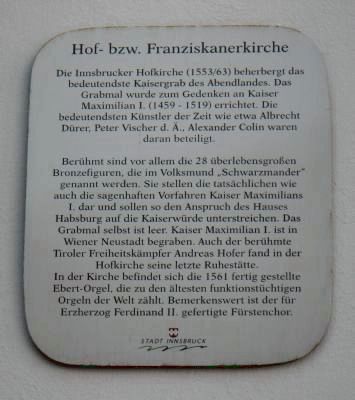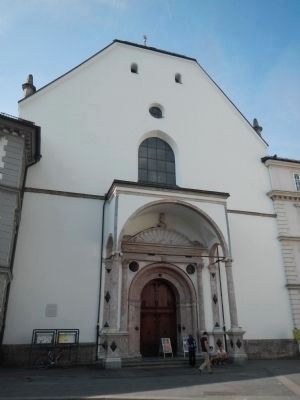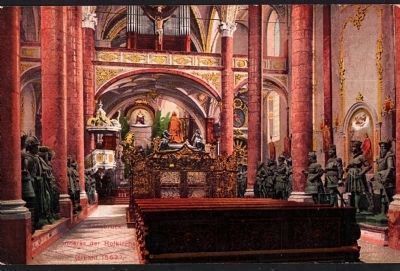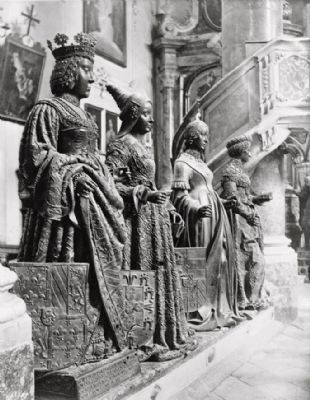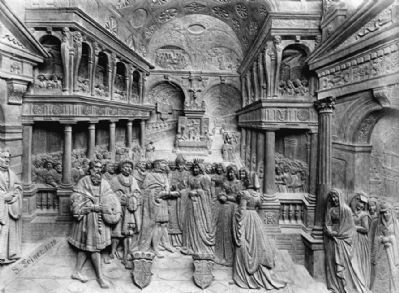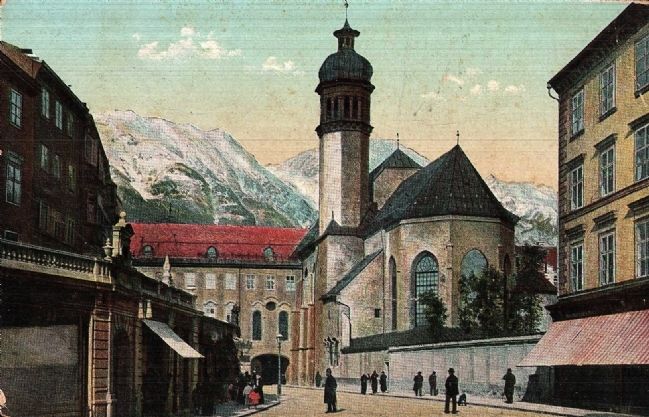Innenstadt in Innsbruck, Tyrol, Austria — Central Europe (Eastern Alps)
The Court or Franciscan Church
Hof- bzw. Franziskanerkirche
Hof- bzw. Franziskanerkirche
Die Innsbrucker Hofkirche (1553/63) beherbergt das bedeutendste Kaisergrab des Abendlandes. Das Grabmal wurde zum Gedenken an Kaiser Maximilian I. (1459 – 1519) errichtet. Die bedeutendsten Künstler der Zeit wie etwa Albrecht Dürer, Peter Vischer d. Ä., Alexander Colin waren daran beteiligt.
Berühmt sind vor allem die 28 überlebensgrossen Bronzefiguren, die im Volksmund “Schwarzmander” genannt werden. Sie stellen die tatsächlichen wie auch die sagenhaften Vorfahren Kaiser Maximilians I. dar und sollen so den Anspruch des Hauses Habsburg auf die Kaiserwürde unterstreichen. Das Grabmal selbst ist leer. Kaiser Maximilian I. ist in Wiener Neustadt begraben. Auch der berühmte Tiroler Freiheitskämpfer Andreas Hofer fand in der Hofkirche seine letzte Ruhestätte. In der Kirche befindet sich die 1561 fertig gestellte Ebert-Orgel, die zu den ältesten funktionstüchtigen Orgeln der Welt zählt. Bemerkenswert ist der für Erzherzog Ferdinand II. gefertigte Fürstenchor.
German-English translation:
Innsbruck's Hofkirche (1553-63) hosts the most significant imperial tomb of the West (i.e the Holy Roman Empire). The tomb was built in commemoration of Emperor Maximilian I (1459 - 1519). The most important artists of the time were involved, such as Albrecht Dürer, Peter Vischer the Elder, and Colin Alexander.
Of particular fame are the 28 larger-than-life bronze sculptures, popularly called the "Black Men". They represent the actual and mythical ancestors of Emperor Maximilian I and are intended to emphasize the claim of the House of Habsburg to the imperial throne. The tomb itself is empty. Emperor Maximilian I is buried in the Wiener Neustadt. The famous Tyrolean freedom fighter Andreas Hofer, however, found his final resting place here in the Hofkirche. The Ebert organ, installed in the church in 1561, can be counted amongst the oldest functioning organs in the world. Also noteworthy is the princely chapel constructed for the Archduke Ferdinand II.
Erected by Stadt Innsbruck (City of Innsbruck).
Topics. This historical marker is listed in these topic lists: Arts, Letters, Music • Churches & Religion. A significant historical year for this entry is 1561.
Location. 47° 16.113′ N, 11° 23.716′ E. Marker is in Innenstadt, Tirol (Tyrol), in Innsbruck. Marker is at the intersection of Rennweg and Universitätsstraße on Rennweg. Touch for map. Marker is in this post office area: Innenstadt, Tirol 6020, Austria. Touch for directions.
Other nearby markers. At least 8 other markers are within walking distance of this marker. The Tower of the Coat of Arms (a few steps from this marker); The New Seminary (within shouting distance of this marker); The Old University (within
shouting distance of this marker); The House of Archduke Sigismund of Tyrol (within shouting distance of this marker); The Teutonic Order House (about 120 meters away, measured in a direct line); Precht House (about 120 meters away); Prechthaus (about 120 meters away); Historisches Rathaus (about 150 meters away). Touch for a list and map of all markers in Innenstadt.
More about this marker. The church is at the intersection of Rennweg, Universitätsstraße, Hofgasse and Burgraben.
Also see . . . The Court Church, Innsbruck. Tyrol.tl's describes the Court Church (in English). On the "Black Men": ...The 40 larger than life-sized statues have, however, never been completed and only 28 were finally brought into being. These “Black Men” (Schwarze Mander) flank the grave-site and give the church the by-name “Black Men church”. Nevertheless the expression is not completely correct, as the bronze statues also comprise women. Among the statues, there are some members of the family of the emperor Maximilian (e.g. his two wives Maria von Burgund and Bianca Maria Sforza),
representatives of Christianity (such as the crusader Gottfried von Bouillon) as well as aristocrats of other courts of Europe, in order to put the emperor’s claims forward. Today the Court Church is the most significant monument of Tyrol and the most striking emperor’s grave-site of Europe. (Submitted on September 8, 2013.)
Credits. This page was last revised on February 1, 2022. It was originally submitted on September 6, 2013, by Barry Swackhamer of Brentwood, California. This page has been viewed 579 times since then and 14 times this year. Photos: 1, 2. submitted on September 6, 2013, by Barry Swackhamer of Brentwood, California. 3, 4, 5, 6. submitted on September 8, 2013. • Andrew Ruppenstein was the editor who published this page.
